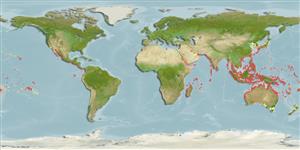Common names from other countries
Environment: milieu / climate zone / depth range / distribution range
экология
; пределы глубины 0 - 20 m (Ref. 349). Tropical
Indo-Pacific.
Length at first maturity / Size / Вес / Возраст
Maturity: Lm ? range ? - ? cm Max length : 6.0 cm SHL самец/пол неопределен; (Ref. 349); common length : 5.0 cm SHL самец/пол неопределен; (Ref. 349)
Collected in large quantities, for food and for the shell (Ref. 349). Abundant on sandy bottoms. Occurs at the low tide mark (Ref. 349). Naticidae are carnivorous prosobranchs which drill holes on their prey such as limpets, barnacles, and other molluscs, especially bivalves (Ref. 833).
Life cycle and mating behavior
половая зрелость | размножение | нерест | икра | Fecundity | личинки
Members of the order Neotaenioglossa are mostly gonochoric and broadcast spawners. Life cycle: Embryos develop into planktonic trocophore larvae and later into juvenile veligers before becoming fully grown adults.
Основная ссылка
ссылки | координатор | соавторы
Poutiers, J.M. 1998. (Ref. 349)
Статус Красного Списка МСОП (Ref. 130435)
Статус СИТЕС (Ref. 108899)
Not Evaluated
Not Evaluated
Угроза для людей
Harmless
Использование человеком
| FishSource |
инструменты
дополнительная информация
ресурсы в Интернет
Estimates based on models
Preferred temperature
(Ref.
115969): 24.4 - 29.3, mean 28.4 (based on 3700 cells).
Уязвимость
Low vulnerability (10 of 100).
Категория цены
Unknown.
